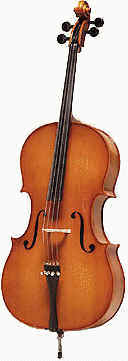
Know More About The Violoncello (Cello)
The violone was the largest member of the viol family so, violoncello
means "small violone". In name at least, then, there is a relationship
between the cello and viol families. It is usual to refer to the bass member of
the violin family as 'cello or cello. (Grammar requires that the abbreviation
apostrophe be used but common usage allows for it to be omitted.) 
The construction of the cello is similar to that of all members of the violin family though one characteristic not present in the violin or viola is the endpin. As a "da gamba" instrument, (that is, one played resting on or between the knees) the modern cello has the addition of the endpin (or spike).
The endpin provides stability and security during performance and this added stability affords cellists less tension in their left hand grip. This, in turn, increases the flexibility in fingering to such an extent that the thumb can be brought more easily into play.
The introduction of the endpin appears to have been during the eighteenth century though at the time of Handel (1685-1759) there are instances of the cello being played resting upon a small table to increase resonance. The endpin, which can be removed or slid into the body of the cello, was introduced to improve the position of the cello in relationship to the player's seated stance. The improved angle, also influenced by the upright necks of the earlier models being supplanted by necks being set back at a slight angle in later instruments, allowed performers easier access to the increasing complexity of the repertoire.
As a member of the violin family, the cello replaced its opposing member in the viol family during the seventeenth and eighteenth centuries though its counterpart, the viola da gamba, outlasted the other members of its family.
It was the renowned craftsmen of northern Italy who were responsible for the early violoncellos, which not only replaced the unrelated viols but also the clumsy bass violins.
The earliest surviving cellos are accredited to Andrea Amati (1505-1580) of Cremona. As is the practice with instruments of genuine provenance, names are bestowed upon them as identified works of the masters. "The King" is one such named violoncello made by Amati. It is so named because the coat of arms of King Charles IX of France can be distinguished upon its back. "The King" is thought to have been a part of the consignment of thirty-eight violoncellos delivered to Charles sometime during his reign of 1560-1574. (Charles it was who granted permission for the St Bartholemew's Day Massacre of thousands of Huguenots. Thirty-eight cellos obviously had insufficient charms to soothe his savage breast!)
The Brescian craftsmen, Gasparo da Salo (1540-1609) and his pupil, Giovanni Paolo Maggini (1580-1630) are also acknowledged as the makers of cellos of great quality. The products of these early masters were bigger than later cellos, being up to 80 cms in length. Many of the early cellos have been reduced in size.
Antonio Stradivari (1644-1737) standardised the length of the cello to 75 cms. An innovation that permitted Stradivari to reduce the length of his cellos was the growing practise of increasing the diameter of the lower strings by overwinding. (The pitch of a string is determined not only by its length but by its diameter: a shorter, thicker string producing the same pitch as a longer, narrower string.)
It is generally accepted that, as with his violins, Stradivari was the finest maker ever of violoncellos.
Early cellos were gut-strung but modern strings are steel or nylon wound with aluminium or silver. Enthusiasts for authenticity still prefer gut strings.
Prior to the eighteenth century it was usual for the cello to be used as a supporting instrument providing bass texture but J.S. Bach, Vivaldi and Boccherini wrote cello concerti in the Baroque period. Brahms and others did likewise during the nineteenth century and Elgar and Shostakovich have provided concerti of merit during the twentieth century.
The vibrant, rich tones of the cello, delivered with subtle, expressive power make it a solo instrument of great distinction. It is a vital member of the string quartet and is indispensable in ensembles of all dimensions. The modern symphony orchestra usually has a complement of about ten violoncellos.
 Back
Back